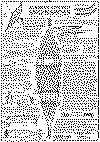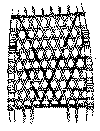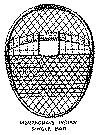By Ben Hunt

[Large File]
It took about an hour to go into the woods, find and cut four elm saplings, trim one set down with a drawknife, and bend them ready for drying as shown in Figure 6.
The other two were laid in the creek with some stones to hold them down. This was done to keep them pliable, so that they could be fashioned a week or so later. Green wood bends very nicely if one doesn't try to do all of the bending in one operation. It must be worked little by little.

Fig. 8
In snowshoes for men, it would probably be well to put cross lacing in the center webbing. This can be done as is shown in Figure 8.

Fig. 9
The Chipewyan Indians made snowshoes similar to those used by the Eskimos, but they made theirs longer and narrower. They put in five crosspieces and used very close webbing of fine rawhide lacing or caribou gut. See Figure 10.

Fig. 10
Long narrow snowshoes are used where open, flat country is to be traversed while the bear- paw type, shown in Figure 9, are used in wooded country and where the going is rough.
Other Snowshoe Plans:
How to Make Chippewa Snowshoes
Simple Snowshoes Made from Wood Boards
Primitive Snowshoes Made from Ash or Hickory Sticks
How to Snowshoe
Additional Bindings
Snowshoe Moccasins